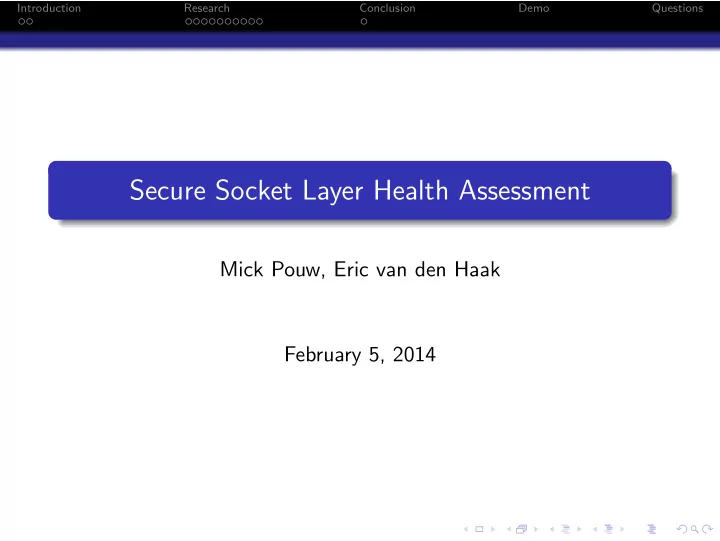

Introduction Research Conclusion Demo Questions Secure Socket Layer Health Assessment Mick Pouw, Eric van den Haak February 5, 2014
Introduction Research Conclusion Demo Questions Introduction 1 Background Research Questions Research 2 Implementing SSL, the right way Common mistakes Classifying mistakes Implementation Conclusion 3 Future work Demo 4
Introduction Research Conclusion Demo Questions Background Background Tilburg University Lots of SSL/TLS services No quick SSL service checking (Manually) Existing tools lack possibility of integrating in existing monitoring software or lack in rating What about a new tool?
Introduction Research Conclusion Demo Questions Research Questions How can we determine SSL “health” of a server side implementation? How can we determine a “bad” SSL implementation? What mistakes are commonly made by server administrators regarding implementing SSL? How can we classify these mistakes? How can we develop a tool that automates checking the SSL “health” of a server side implementation?
Introduction Research Conclusion Demo Questions Implementing SSL, the right way Implementing SSL, the right way Certificates Protocols Server settings
Introduction Research Conclusion Demo Questions Implementing SSL, the right way Certificates Subject Validity (Chain of) Trust Hash algorithm Debian weak key Revocation
Introduction Research Conclusion Demo Questions Implementing SSL, the right way Protocols SSLv2 must be disabled SSLv3 should be disabled, backwards compatibility TLSv1.0 should be enabled TLSv1.1 should be enabled TLSv1.2 should be enabled
Introduction Research Conclusion Demo Questions Implementing SSL, the right way Server Settings Compression (Crime) RC4 (Randomness) MD5 (Collision) Strong key size (Brute force) Perfect forward Secrecy (Future decryption)
Introduction Research Conclusion Demo Questions Common mistakes Common mistakes Test Percentage passed Signature hash algorithm 100% Certificate (chain) trusted 100% Certificate is valid 100% No Debian weak keys 100% Subject name matches 91% Compression disabled 100% Cipher suites do not contain MD5 57% Perfect forward secrecy available 46% Cipher suites do not contain RC4 17% Key length at least 128bits 89% SSLv2 disabled 94% SSLv3 disabled 3% TLSv1.0 enabled 97% TLSv1.1 enabled 63% TLSv1.2 enabled 63%
Introduction Research Conclusion Demo Questions Classifying mistakes Determining a test Weight (0 < = weight < = 100) Required (Show-stopper) Example test Name Example Proposition Requirement in order to pass the test Weight 50 Required No
Introduction Research Conclusion Demo Questions Classifying mistakes Formulas { requiredtests } ⊂ { passedtests } (1) The set of all required tests has to be a subset of all passed tests. N � p i i =1 100 ∗ (2) M � t j j =1 Where p is a set of all weights of the passed tests and t is a set of all weights of all performed tests.
Introduction Research Conclusion Demo Questions Classifying mistakes Classification Description Weight Required Signature hash algorithm 80 No Certificate (chain) trusted 0 Yes Certificate is valid 0 Yes No Debian weak keys 100 No Subject name matches 0 Yes Compression disabled 50 No Cipher suites do not contain MD5 50 No Perfect forward secrecy available 50 No Cipher suites do not contain RC4 80 No Key length at least 128bits 80 No SSLv2 disabled 100 No SSLv3 disabled 30 No TLSv1.0 enabled 75 No TLSv1.1 enabled 100 No TLSv1.2 enabled 100 No
Introduction Research Conclusion Demo Questions Implementation Proof of Concept Python Used software SSLyze OpenSSL Curl Modular framework Tests Output
Introduction Research Conclusion Demo Questions Implementation Running the tool! Entire Tilburg University IPv4 space SURFnet IDP page hosts Score SURFconext UvT < 40% 5 27 40-50% 8 1 50-60% 82 64 60-70% 9 6 70-80 % 13 1 > 80 % 20 32
Introduction Research Conclusion Demo Questions Conclusions Found a new way of determining SSL “Health” Developed a proof of concept that assess SSL services
Introduction Research Conclusion Demo Questions Future work Future work Start TLS Server Name Indication (SNI) for HTTPS Improve framework’s dependencies
Introduction Research Conclusion Demo Questions Demo
Introduction Research Conclusion Demo Questions Questions?
Recommend
More recommend